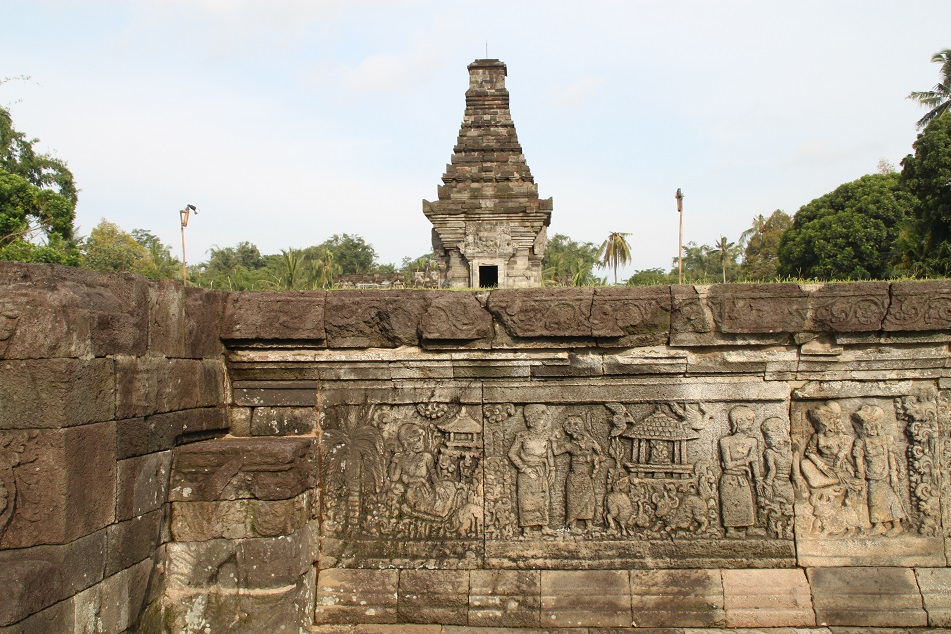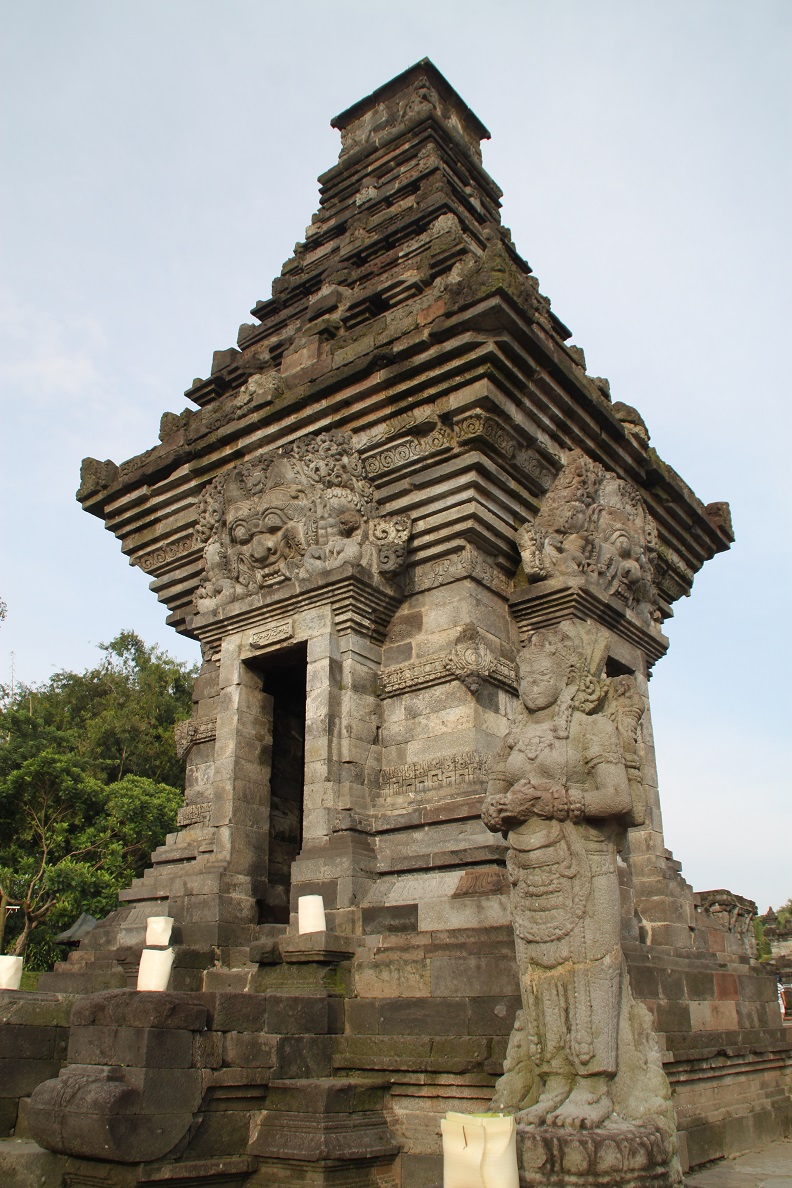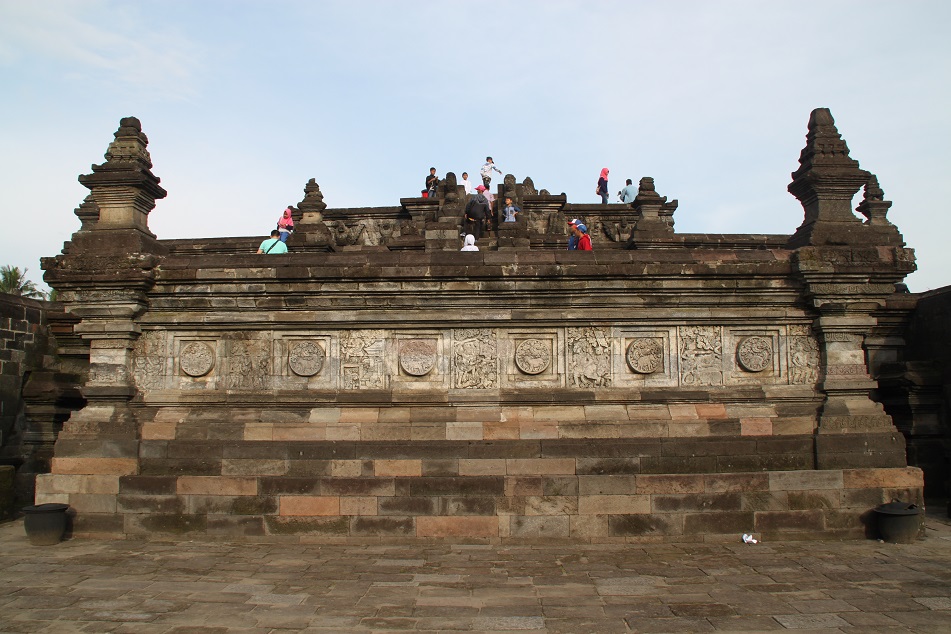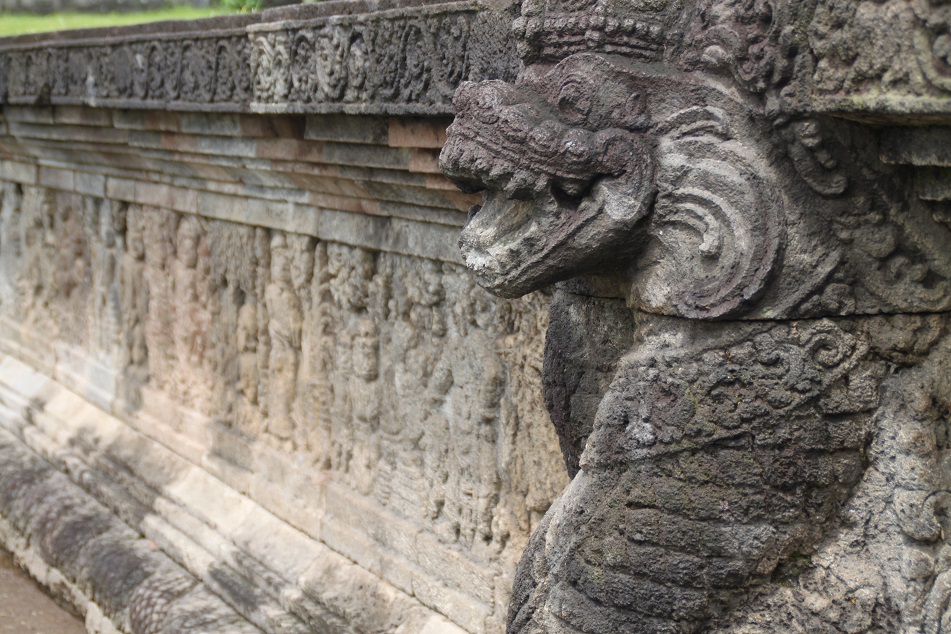Swirling tongues of fire welcomed erstwhile royal families and priests who ascended the stairs of Palah, a late 12th-century Hindu temple located on the southwestern slopes of Mount Kelud. The volcano was so active and unpredictable that a temple was deemed necessary to appease Acalapati, the mountain god, so he would spare the surrounding settlements from his erratic wrath. Inspired by Krishnayana (Krishna’s life told in an epic poem), the upper walls of the temple were encrusted with bas-reliefs depicting scenes from the epic. One panel portrayed Krishna’s escape from Kalayawana (Kalayavana), a ruthless king who was killed by Muchukunda through his burning gaze (another version of the story refers to Wiswamitra/Vishvamitra as the killer of Kalayavana). The flames were indeed a metaphor for Kelud’s volcanic eruptions.
More than eight centuries later, I find myself looking at the same weathered relief, carved on andesite rock on the second level of the stone platform. The motif itself is not instantly recognizable, but on a closer inspection the outline of the flames is clearly the centerpiece of the ornately-carved panel. Penataran, as Palah is known today, was commissioned by the king of Kediri, a kingdom that emerged as a prominent power in eastern Java during the mid-11th century.
Two centuries before the construction of Penataran, Java was already home to great Hindu and Buddhist temples, including Borobudur and Prambanan, both built by the Central Javanese rulers of the Medang kingdom. As the center of power on the island gradually shifted to the east in the decades that followed, new temples were commissioned around the new capital. However, unlike most Central Javanese temples which followed a concentric layout (also known as mandala, representing the Hindu-Buddhist universe) with the most important structure located at the center of the temple compound, Penataran – the largest Hindu temple in East Java – was constructed in a linear layout where the sanctum is situated at the back of the compound. This centuries-old layout is in fact still used in Bali to build Balinese Hindu temples known as pura.
For three centuries since its completion, new structures were added to Penataran temple complex by different rulers of East Java. Candi Naga, ‘dragon temple’, was commissioned in the 13th century when this part of Java was controlled by the kingdom of Singhasari. Named after its distinctive serpentine carvings, held by nine figures clad in opulent costumes, the temple is believed to have functioned as a reliquary for sacred weapons. In front of Candi Naga lies Candi Candra Sengkala, a 14th-century tall and slender addition to the temple compound. Constructed in a typical East Javanese architectural style, the temple was built under the rule of Hayam Wuruk, the greatest of all Majapahit kings. Majapahit itself was the last great Hindu kingdom to ever rule much of Java.
Following the decline of Majapahit as more and more people on the island converted to Islam, Penataran’s importance gradually diminished until it was completely abandoned. In the span of centuries, neglect and natural disasters caused heavy damage to the formerly imposing temple. The rediscovery of Penataran is credited to Thomas Stamford Raffles, a British colonial governor at a time when Java was briefly occupied by the British. The ruins of the temple were first mentioned in a 1815 account, although reconstruction work did not begin in earnest until many years later.
Further studies revealed that the lower walls of the three-tiered main temple were adorned with stories from the Ramayana, one of the greatest and most well-known Hindu epics alongside the Mahabharata. The Ramayana had inspired ancient Javanese sculptors to immortalize figures, animals, plants and other motifs from the epic on andesite rock – widely available in volcanic Java – which were then used to decorate a plethora of Hindu temples on the island. However, Penataran’s medallions – depicting real and mythical animals – are unique to the temple as they aren’t found on any Central Javanese temple.
In front of Candi Candra Sengkala is Batur Pendapa, where it is believed that devotees once placed offerings in religious ceremonies. Modern-day visitors would likely notice the strange look of the main sanctum, Batur Pendapa, as well as Bale Agung – also located at the front part of the compound – for they all seem to have lost their upper structures. Believed to be made from perishable materials – possibly wood and ijuk (palm fiber) – these structures have long succumbed to the power of nature. Fortunately some relief panels at the lower part of the main temple suggest how the whole structure used to look, which unsurprisingly reminds me of some Hindu temples in Bali given the fact that many Javanese royals fled to the neighboring island following the decline of Hinduism in Java.
Apart from the architecture, what stays the same is the activity of Mount Kelud itself. Unlike most accounts about volcanic eruptions across the archipelago which were exclusively written by the Europeans during the colonial period, Kelud’s eruption was mentioned in a 14th-century epic Javanese poem. The volcano erupted in the same year when Hayam Wuruk was born, perceived by the locals as a divine sign of great things the baby would accomplish in his life – Majapahit was in fact at its peak during Hayam Wuruk’s rule. Interestingly, centuries after the island’s conversion to Islam and the arrival of Christianity from Europe, the Javanese reverence toward volcanoes has barely changed.
In 1901, Kelud erupted again with a mighty explosion (heard hundreds of kilometers away) and an ash cloud that reached as far as West Java. Two weeks later, a baby boy was born, and as goes with tradition, the locals saw this as an omen of something great about to happen to him. Less than five decades later, the same boy had grown up to become none other than the first president of Indonesia. Even in the 21st century, volcanic eruptions are often interpreted as a prelude to major political events. But when no such thing occurs following an eruption, the locals will still tell you stories about Mount Kelud with a sense of veneration, pride and astonishment.
“When Kelud erupted in 2014, Yogyakarta was covered in thick ash,” a local tells me in reference to Kelud’s latest major eruption which paralyzed the city, more than 200 km away to the west of the volcano. The ash forced the closure of major airports across Java, causing weeks-long travel disruptions. “But strangely, Blitar was safe,” he adds, referring to the nearest city to the volcano. As tempting it is to explain the phenomenon from a scientific perspective, to him and many other people Penataran seems to serve its purpose after all. It has been protecting the surrounding areas from the wrath of the mountain god, more than eight centuries since its completion.





















Beautiful photos!! Temples are such beautiful cultural sights!!
LikeLiked by 2 people
Thanks Ryan! What you said about ancient temples is exactly the reason why I’m so fascinated by them.
LikeLiked by 1 person
Great post, Bama. As ever, you do a great job narrating the history and capturing all those incredible sculptural details. If only the visitors we encountered were a bit more mindful about safeguarding their history… I’ll admit I got upset seeing the litter left around and children running everywhere while touching the precious reliefs. I wonder why Penataran is still not very well known among Indonesians – when we returned to Jakarta and I told my coworkers about it, none of them had ever heard of the temple.
LikeLiked by 1 person
Thanks James! When I saw those kids hanging from some of the statues, I felt really helpless. Maybe I should have told them not to do that. But if I did that, I wonder if they would understand the reason why I told them so, because the awareness of the importance of cultural heritage conservation should be systematically taught at home and school. Otherwise they would have just run away and returned when I was not watching. Then of course, the littering problem. From volcanoes to beaches, ancient temples, and religious sites, nowhere is spared from trash. As for the why Penataran is not that well-known even among Indonesians, I think it’s because of its location which is not as easily accessible from big cities as Borobudur or Prambanan.
LikeLiked by 1 person
Hindi-influenced architecture is magical.
LikeLike
Indeed. Equally interesting is how local cultures across Southeast Asia left their own marks on ancient Hindu-Buddhist temples in the region. Those in Indonesia, Vietnam, Cambodia, Thailand and Myanmar have their own distinctive characters.
LikeLiked by 1 person
Thanks for the info. I hope to visit Myanmar and India soon!
LikeLike
You’re welcome, and I certainly hope you’ll go to both countries sooner than later!
LikeLiked by 1 person
Sure will, but India is so over-whelmingly big, I wouldn’t know where to start. Any ideas?
LikeLike
It is. Hmmm, I haven’t been to the north, and that is where most people go — Varanasi, New Delhi, Agra, Rajasthan, they’re all in the north. I spent a month exploring the south, so I could suggest a few places in that part of India to you.
LikeLiked by 1 person
I think the north is a good place to start for newbies like me. Thanks for the advice.
LikeLike
And there should be more international flights from the north. You’re welcome.
LikeLiked by 1 person
Great photos and I love this myths that are connected to each eruption
LikeLike
Thanks Mallee! The lives of many Indonesians are indeed inseparable from volcanic activities, so much so each eruption is often seen as an omen of things to come.
LikeLiked by 1 person
Cultural places always been a great sighting… love your pictures
LikeLike
I happen to be one of those people who adore intricate ancient temples — they’re truly masterpieces from the past, aren’t they? Thanks for dropping by, Abhishek.
LikeLiked by 1 person
Yep you are absolutely right 😊
LikeLike
Semoga saya bisa kembali ke Penataran, meski itu berarti berkendara 100km dari Malang menuju Blitar, haha. Memang bagus banget candi satu ini. Dari Dwarapala di depan dan semua-muanya sudah sangat mirip dengan bagaimana pura-pura Hindu dibangun hari ini. Banyak hal yang dapat digali dari candi ini, dari kepercayaan di masa itu, sampai hubungan dengan para mitreka satata di seberang lautan. Sebuah negara besar sudah menjelma pada saat itu dan semoga bisa kita ingat-ingat terus, hehe.
LikeLike
Amin, semoga ya Gara. Saya penasaran apa struktur di atas Candi Penataran itu dulunya mirip susunan meru di pura-pura Bali ya? Soalnya banyak aspek dari kompleks percandian ini yang mengingatkan saya akan Bali, bahkan pahatan singa bersayap di langkan atas struktur batu yang masih bertahan sekarang sedikit banyak mengingatkan saya akan pahatan yang serupa di Bali. Betul, semoga kita semua terus tertarik untuk mempelajari sejarah negara besar tersebut. Bicara tentang mitreka satata Majapahit, saya akhir-akhir ini sedang lumayan menggali informasi mengenai Kerajaan Champa gara-gara habis mengunjungi My Son. Luar biasa memang hubungan yang terjadi di masa silam.
LikeLike
Singa bersayap itu mungkin yang nantinya jadi Singa Ambara Raja kali ya Mas, haha. Ya, pernah ada yang merekonstruksikan bentuk atap candi di masa lalu dan pada akhirnya jadinya meru.
Wah, keren banget bisa menyambangi Champa. Saya sejauh ini cuma bisa memandang-mandang yang di Indonesia, semoga suatu hari nanti bisa ke sana.
LikeLike
Haha, jadi teringat kampung halaman dong Gara. 🙂 Semoga kesempatan untuk mengeksplorasi candi-candi peninggalan Kerajaan Champa bisa segera datang ya, Gara. Tiket ke sana pun sekarang sudah gak semahal sebelum ada low-cost airlines.
LikeLike
Amin, terima kasih banyak Mas 😁😁
LikeLike
Bama what a great post combining history and architectural detail. Thanks for the education and sharing the visit with us. Beautiful photographs.
Peta
LikeLike
Thanks Peta! Glad this post gave you a little information about a place even most Indonesians are not aware of. Penataran was really beautiful and impressive, although from the photos it might not look that big. Tomorrow I’m leaving for East Java again to explore more ancient temples there.
LikeLike
Amazing place!
LikeLike
Penataran really is exotic, mysterious and beautiful.
LikeLiked by 1 person
I am surprised that this place gets so little attention. Look at those intricate carving, it is as beautiful and sophisticated as the one in Angkor. This temple looks much better than the Ruin of My Son in Vietnam, only bricks 🙂 After seeing many of your posts about Indonesia, I realized that the country is diverse and has more to offer than just Bali. Bali is indeed beautiful but it can only reflect a part of the Indonesian culture.
LikeLike
Well, even for Indonesians, going to the ‘usual’ places can be far more attractive than visiting some ‘obscure’ temples like Penataran. Bali is always crowded during holiday season — although justifiably so. But with more than 13,000 (or 17,000 depending on who you ask) islands across the country, for sure there are more than just Bali to explore in this sprawling archipelago. Even people who live on the same island can practice cultures so different from one another and speak languages unintelligible to each other. Glad this post brought up that thought, Len.
LikeLiked by 1 person
I think Indonesia is a bit shy, despite the fact that it is the largest country in ASEAN. Could it be that the country does not want to attract mass tourism?
LikeLike
Actually in recent years the government have been trying to attract as many foreign tourists as possible to visit Indonesia, and they’ve also chosen several places to be ‘the next Bali’. I personally think each place in the country is unique, and it doesn’t have to be another Bali, which is fascinating in its own sense.
LikeLike
Thanks to you I get a taste of these foreign cultures. Thank you!
LikeLike
Glad my blog provided you with a glimpse of cultures from the other side of the world. You’re very welcome, Adelheid, and thank you for reading!
LikeLike
Always impressed by the history and knowledge that fills your posts!
LikeLike
Thanks Rebecca! Places steeped in history are always fascinating to explore. There are so many layers to learn about, and every time I do a little research I’m always reminded of how much more there is to discover in the world.
LikeLike
Such stunning bas reliefs! And so well captured. Are those fierce winged snake hoods water spouts? Thank you for sharing another Indonesian gem, Bama. Hadn’t heard of this gorgeous temple before.
LikeLike
I had been dreaming of going to this ancient Hindu temple for a long time and it really didn’t disappoint! Those winged snakes are purely decorative elements of the temple. Despite its size and significance, actually a lot of Indonesians haven’t even heard of Penataran. I think you would enjoy exploring this temple, Madhu.
LikeLiked by 1 person
I most certainly would!
LikeLiked by 1 person
From your South Sulawesi post :
“A while ago I read about how two groups of people who live in two places on earth, distant from one another, and have no contact at all can develop similar artistic expressions.”
“This explains those ancient cave paintings found in different corners of the world, as well as why pyramid-like structures were built not only in Egypt, but also in Central America and Asia, for instance.”
Could you share the title and the author of the book ?
What dou you think about :
Hotrai Wat Phra Sing in Chiang Mai, Thailand comparing to Candi Naga in Candi Penataran complex ? Are they fit with the theory above ? or one influenced another ? or they were influenced from the same source ? or no similarity ?
I propose you to make another post of Candi Penataran, only to show the pictures of intriguing foreign customs depicted in the walls of main temple. Since the issue already raised long time ago, i wonder how the comments of your foreign readers.
Last year i read the jurnal of westerner discuss gamelan of Java and their evolution. He also mention the carving in Candi Penataran which depicting two men playing xylophone or metalophone facing each others. One dresses like Javanese, another one dresses with something like turban ussually wearing by African. He also stressing why no one of archeologist try to discuss and looks avoiding this matters.
Another researcher (Dick-Read) who wrote Phantom Voyager already mentioned the possibility of Indonesian influenced in Africa including music instruments, long before.
Things make itchy of mind :
Is it possible that carving in Candi Penataran only a creativity of the artist, which coincidently similar with some costums of ethnicity in Africa and America ?
Do you recognizing the origin ethnic in Central and South America, have similarity look with ( say Javanese or Khmer ) ?
The most recent research of Lembaga Eijkman, the DNA of Javanese is mixed, but dominated by Austroasiatic not Austronesian. Thats why the look of Javanese is so similar with Khmer (which is Austroasiatic). The pure Austronesian is Mentawai ethnicity which looks so mongoloid.
And long before, one of archeologist (Coedes) said that Shailendra is Fu Nan, which origin of Khmer.
In the National Museum, i saw a display of copper plates inscription ( dont remember the Majapahit era, or Mataram Hindhu era) which stated of swearing a society in village that they are Javanese not Khmer, so they have to be liberated from tax of foreigner. Means for century ago the people already seeing the similarities look between Javanese and Khmer, so they need to swear to convinced.
From the things that confusingly connected and tied one of the others, any idea ?
LikeLike
Hi Sapto!
As usual, I’m always impressed by the wealth of information you have. I still have to learn so many things, and along the way I share what I read or heard on my blog. As for the title of the book, unfortunately I don’t remember at all as it’s been a while since I read about it.
I really appreciate everything you said and proposed. However, I think I should leave the interpretation of the relief panels to scholars and archaeologists. I would be happy to share on my blog whatever they conclude, though.
LikeLike
Pingback: Singhasari: Bloodshed and Beauty | What an Amazing World!
Pingback: Blitar under the Radar | What an Amazing World!
Pingback: Trowulan: An Ancient Javanese City | What an Amazing World!
Pingback: Ngawen & Losari: Temples on the Outskirts of Jogja | What an Amazing World!
Mengagumkan bagaimana dalam periode pendudukannya yang sangat singkat, Raffles berhasil memberikan kontribusi dalam banyak hal buat perkembangan sejarah, ilmu sosial dan budaya, bahkan biologi. Menemukan dan mengawali ide untuk menggali kembali reruntuhan candi (termasuk borobudur ya kalau ga salah), menulis buku yang sangat tebal tentang kondisi Jawa dan kebudayaannya, serta masih sempat menyelamatkan spesimen bunga raflessia jenis baru yang ditemukan di Bengkulu. Kadang-kadang suka ngayal kenapa ya dulu kita ga dijajah yang lamanya sama Inggris aja. Hahaha..
Btw, ada info berapa persen bangunan candinya yang masih asli dan yang hasil renovasi ga Mas? Satu lagi, apa di candi ini batu-batu dan relief yang berasal dari restorasi juga ditandai titik putih di tengah seperti di candi Borobudur dan Prambanan? Waktu ke sana dulu saya lupa merhatiin karena udah rada sore dan ga terlalu terang hehe.
LikeLiked by 1 person
Wah kebetulan nih isu Raffles disinggung di sini. Jadi dulu saya pun berpikir hal yang sama, bahwa berkat Raffles berita tentang suatu candi megah di Jawa bernama Borobudur bisa menyebar ke Eropa. Tapi beberapa tahun terakhir semakin saya membaca sejarah Raffles, semakin saya paham bahwa dia adalah seorang tokoh yang problematik sebenarnya. Bahkan di Singapura pun, kota yang didirikan oleh Raffles, semakin mencuat diskusi mengenai sisi gelapnya Raffles.
Soal dijajah Inggris, ya bukan jaminan kondisi kita sekarang bakal lebih bagus sih. Kalau lihat Singapura dan Malaysia, iya mereka lebih maju dibanding Indonesia. Tapi kalau melihat beberapa negara lain seperti Bangladesh dan Zimbabwe sih, enggak deh makasih, hehe.
Nah, saya waktu ke Penataran gak terlalu memperhatikan batu-batu dengan titik putih. Tapi yang pasti ada beberapa batu yang warnanya berbeda/lebih terang yang bisa dipastikan itu bukan batu asli penyusun candi.
LikeLiked by 1 person
Benar juga sih, bagaimanapun penjajahan tetap aja penjajahan ya. Tadinya saya pikir karena komparasinya negara-negara tetangga kita semacam Malaysia, SG, Brunei, atau Aussie, yang secara kasat mata terlihat “di atas” negara kita. Tapi mungkin memang beberapa negara Afrika yang juga dijajah Inggris ga “seberuntung” negara-negara tadi Haha…
Saya baru dengar kalau ada sisi gelapnya juga si Raffles, nanti coba gugling baca-baca dulu kalau gitu hehe.
Thanks infonya, Mas Bama!
LikeLiked by 1 person
Ada juga contoh negara bekas jajahan Inggris yang masih di Asia Tenggara, tapi keadaannya sekarang gak “seberuntung” Malaysia atau Singapura: Myanmar. Jadi bukan jaminan kalo dijajah Inggris pasti lebih enak. 🙂
LikeLiked by 1 person
Oiya deng Myanmar hahaha.. Thanks, Mas Bama.
LikeLiked by 1 person
Sama-sama.
LikeLike